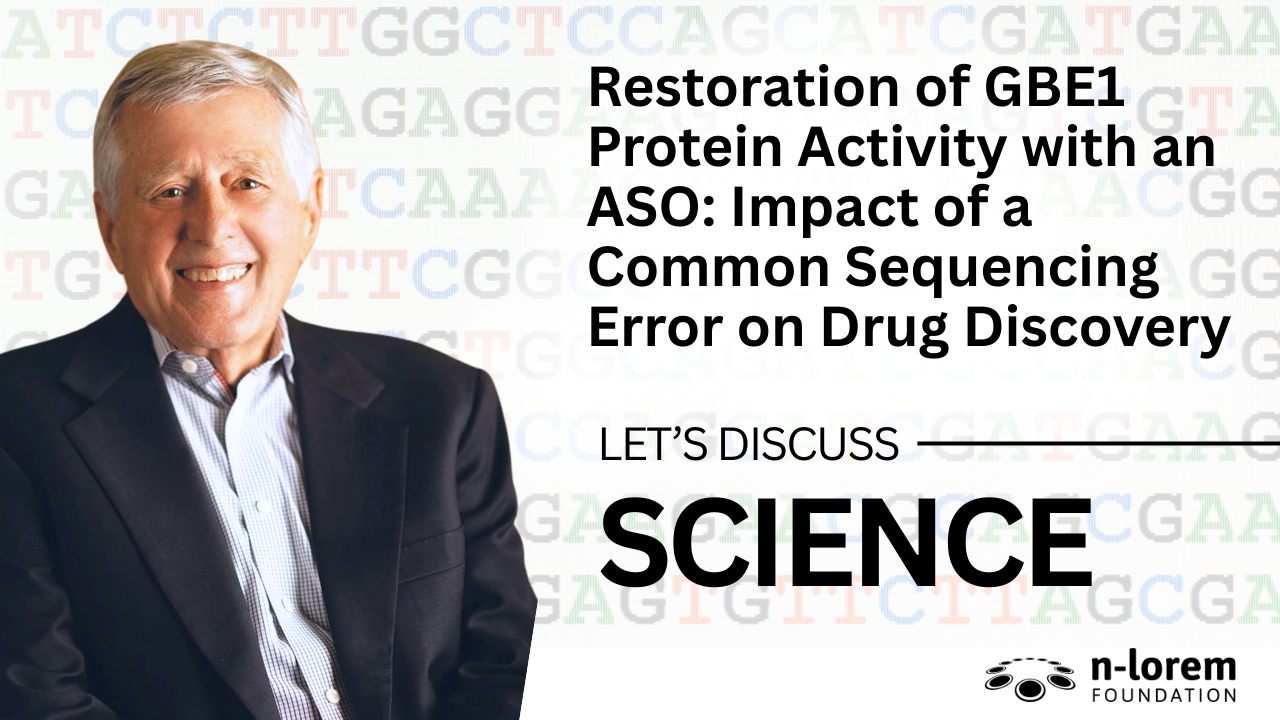Let’s Discuss Science
Restoration of GBE1 Protein Activity with an ASO: Impact of a Common Sequencing Error on Drug Discovery
August 19, 2025 by Dr. Stan Crooke

Glucose and Glycogen
Glucose is a major source of energy for cells via both glycolytic and oxidative phosphorylation (TCA) pathways, but glucose intake varies as does the level of glucose in blood. Blood glucose levels are carefully regulated by several hormones. The pancreas secretes glucagon and insulin as well as several peptide hormones like GLP-1 that control glucose levels in blood within a very narrow range. Given the essential role of glucose in supplying the energy needed by cells and the fluctuation in glucose ingestion and availability, cells store glucose in a form that can be readily broken down to provide glucose on an as needed basis. The form of glucose that is stored in cells is glycogen. Glycogen is basically just a polymeric form of glucose that can be readily synthesized and degraded by specialized enzymes. To be optimally stored, glucose molecules are linked head to tail in glycogen, but to be readily degraded by enzymes, glycogen must be branched. There are multiple enzymes that synthesize glycogen and branch it and multiple types of enzymes that degrade it.
Glycogen Storage Diseases
Glycogen must be properly stored in cells, or it is very toxic. As a very large polymer, if glycogen is improperly stored, it can aggregate and trap other cellular molecules in those aggregates which leads to cellular dysfunction and death. Any failure to synthesize and branch glycogen or any failure to degrade glycogen can lead to severe diseases. Since the liver is the main storage site for glycogen and the CNS uses incredible amounts of energy and therefore every nerve cell must have high levels of glycogen, these are often the organs most severely affected by glycogen storage diseases.
Glycogen Branching Enzyme 1
Since proper branching of glycogen is critical to cell health, there are several enzymes that are responsible for branching. One such enzyme is Glycogen Branching Enzyme 1 (GBE1). As the name suggests, this enzyme participates in glycogen synthesis and is responsible to introduce branching into the polymer. As glucose has several chemically reactive hydroxyls, branching just requires an enzyme that connects glucose molecules through hydroxyls that lead to glucose molecules not being head-to tail, but rather sort of side by side.
GBE1 disease
GBE1 disease is a severe genetic disease due to loss of function mutations in GBE1. Patients with dysfunctional GBE1 accumulate glycogen in inclusion bodies in cells that are called polyglucosan bodies; hence the name Adult Polyglucosan Body Disease (APBD). Symptoms typically manifest after 40 years of age and include progressive neurodegeneration, peripheral neuropathy, weakness, neurogenic bladder, spasticity and autonomic dysfunction. The second most common mutation is an intronic variant in which a novel splice site is generated. The mis-spliced variant creates a pseudo-exon that has a premature stop codon (PTC) and is subject to nonsense-mediated decay (NMD) resulting in loss of the protein and enzymatic activity and a steady increase in mis-formed glycogen that accumulates in polyglucosan bodies.
Several patients with this mutation and rapidly progressive disease have applied for treatment and been accepted. To correct the mutation, our plan was to devise splice switching PS 2’-MOE ASOs that block the ectopic splice site.
Discovery of Effective PS 2’-MOE ASOs to Treat Patients with ABBD Caused by the Second Most Common Mutation in GBE1
In Thomas et.al. (Splice-modulating antisense oligonucleotides targeting a pathogenic intronic variant in adult polyglucosan body disease correct mis-splicing and restore enzyme activity in patient cells. Nucleic Acids Research, Volume 53, Issue 13, 22 July 2025, gkaf658, https://doi.org/10.1093/nar/gkaf658), we describe the discovery of a novel PS 2’-MOE ASO and the effects of the ASO on the correction of the cellular phenotype in patient iPSC-derived neurons. Our work demonstrates how a very common single nucleotide mis-read of a whole genome sequence can result in significant delays in ASO discovery. To begin, we confirmed that the mis-splicing at the ectopic splice site was the cause of the cellular phenotype by first identifying the various GBE1 RNA isoforms and their relative levels. As the low levels of mis-spliced RNA isoform suggested that NMD was activated, we then confirmed that indeed NMD was activated and was responsible for the loss of GBE1 activity, protein and pre-m-RNA. We designed multiple PS 2’-MOE ASOs to tile the published sequence of the ectopic splice site and indel. In our work, we observed that ASOs that had a mismatch in the MT seemed to be a bit more potent at increasing properly spliced GBE1 RNA and reducing m-RNA from the ectopic splice site. This finding was not expected, and we suspected that there might be inaccurate information published. We characterized the sequence more thoroughly and identified a sequencing error that explained the anomalous results. We then confirmed that ASOs fully complementary to the correctly sequenced site were, indeed, most effective at reducing ectopically splice pre-m-RNA and increasing correctly spliced forms.
Working with our collaborators, we then demonstrated that GBE1 enzyme activity was significantly increased and subjected the ASOs to our standard approaches to select only optimized ASOs for further development.
Conclusion
In conclusion, we have successfully discovered and are developing PS 2’-MOE ASOs to correct the second most common cause of APBD.

We cannot do
this alone
Together we are changing the world—
one patient at a time
We hope that you join us on this journey to discover, develop and provide individualized antisense medicines for free for life for nano-rare patients. The ultimate personalized medicine approach – for free, for life.
Follow us on social for updates on our latest efforts

